|
|
|
Sort Order |
|
|
|
Items / Page
|
|
|
|
|
|
|
| Srl | Item |
| 1 |
ID:
174718
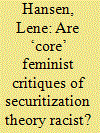

|
|
|
| 2 |
ID:
174715
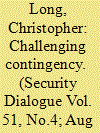

|
|
|
|
|
| Summary/Abstract |
Understandings of the nature or inherent workings of molecular life in the field of biopolitical security studies have today been characterized predominantly in terms of contingency. This article challenges this characterization. It does so by identifying a particular logic of operation that organizes political action and intervention at both the level of the population and the molecular in response to the threats of smallpox, Ebola and pandemic influenza. It argues that, in fact, rather than securing by instantiating a general economy of the contingent, governing practices rely upon the characterization of the nature of molecular life in terms of its constant biological dynamics. Governments around the world, and the US government in particular, have reacted to the increased likelihood of the emergence of disease through the stockpiling of new pharmaceuticals, including the antivirals ST-246, ZMapp and Tamiflu. Antivirals represent a pharmaceutical tool stockpiled by governments to ensure that they can respond to the emergence of novel biological threats. The characterization of the nature of molecular life in terms of its constant biological dynamics is so important, then, as it is this that underpins political programmes of preparedness that utilize antivirals in the prevention of disease.
|
|
|
|
|
|
|
|
|
|
|
|
|
|
|
|
| 3 |
ID:
174713
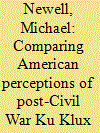

|
|
|
|
|
| Summary/Abstract |
Recently, public debates have questioned whether or not the American government responds differently to terrorism by white, right-wing, Americans. This article examines a historical period in which similar dynamics were on display in state responses to the Reconstruction-era Ku Klux Klan (KKK), Irish-American Fenians, and anarchists from 1860 to 1920. This history suggests that political officials responded to these groups more on the basis of ideas than their actual levels of violence, including discourses of Americanism shaped by ideology, nativism, and racism. Successful claims to ‘Americanism’ lent the KKK a sense of familiarity that led it to be seen as less of a threat to ontological security, even as it posed a significant threat of physical violence. In contrast, the ideologically subversive and foreign anarchists were responded to more severely, despite being responsible for far fewer deaths and injuries than the KKK. This history suggests that American counter-terrorism has been influenced by factors of racial and national belonging in the past, and provides significant context for the consideration of current debates about responses to right-wing groups.
|
|
|
|
|
|
|
|
|
|
|
|
|
|
|
|
| 4 |
ID:
174714
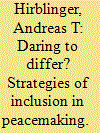

|
|
|
|
|
| Summary/Abstract |
‘Inclusion’ has emerged as a prominent theme in peacemaking. However, its exact meaning remains vague, as do assumptions about the relationship between inclusion and peace. This article seeks to problematize the research, policy and practice of inclusion. Focusing on United Nations (UN) peacemaking, we ask how the object of inclusion has been framed, and based on what strategies and underlying rationales. We do so against the backdrop of emerging debates about an agonistic peace, which suggest that violent antagonistic relationships can be overcome if peace processes enable contestation between adversaries. This requires that peacemakers recognize the constitutive role of difference in political settlements. We identify three distinct strategies for inclusion, with corresponding framings of the included. Firstly, inclusion can be used to build a more legitimate peace; secondly, to empower and protect specific actor groups; and thirdly, to transform the sociopolitical structures that underlie conflict. The first strategy frames the included in open terms that can accommodate a heterogeneity of actors, the second in closed terms pertaining to specific identity traits, and the third in relational terms emerging within a specific social, cultural and political context. In practice, this leads to tensions in the operationalization of inclusion, which are evidence of an inchoate attempt to politicize peace processes. In response, we argue for an approach to relational inclusion that recognizes the power relations from which difference emerges; neither brushing over difference, nor essentializing single identity traits, but rather remaining flexible in navigating a larger web of relationships that require transformation.
|
|
|
|
|
|
|
|
|
|
|
|
|
|
|
|
| 5 |
ID:
174717


|
|
|
|
|
| Summary/Abstract |
Approximately 8,000 boys and men were killed in the 1995 Srebrenica genocide. The victims were disappeared, killed and buried in secret mass graves. In this article, I examine how forensic anthropologists, demographers and forensic geneticists produced technolegal knowledge about the number of victims in the wake of the genocide; how those numbers were validated in legal proceedings against those held responsible; and, finally, how some have tried to destabilize the numbers in attempts to deny that a genocide was committed. While numbers, and the larger category of knowledge, take centre stage in the discussion, I use Srebrenica’s aftermath to introduce the concept of ontologically dirty knots, which is an analytical and methodological innovation that enables us to produce scholarly accounts of events, such as the Srebrenica genocide, that are characterized partly by secrecy, partly by controversy and partly by materiality. It ties together meaning and materiality, signals a process that continues to evolve, and suggests that narratives about what happened are the results of entanglements, action and friction that can be undone. In these respects, the article addresses current discussions on actor-network theory within critical security studies.
|
|
|
|
|
|
|
|
|
|
|
|
|
|
|
|
| 6 |
ID:
174719


|
|
|
| 7 |
ID:
174716
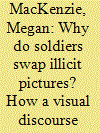

|
|
|
|
|
| Summary/Abstract |
Military service members have been taking and circulating illicit images for decades, and soldier-produced illicit images are a regular and coherent category of international images. Focusing on two case studies – Abu Ghraib images and images of hazing – the argument put forward in this article is that soldier-generated illicit images are not simply photographic evidence, or accidental by-products, of exceptional military activities; rather, these images – and the practices associated with these images – are central to, and reinforce aspects of, military band of brother culture. Soldier-produced illicit images establish a visual vernacular that normalizes particular practices within military communities. Moreover, the practices of producing, circulating and consuming these images convey explicit messages to service members about acceptable behaviour and norms around loyalty and secrecy. A method of visual discourse analysis is developed and employed to examine the acts captured in soldier-generated illicit images as well as the practices linked to the production, circulation and consumption of images. Building on existing work on military culture and images and international relations, this article makes a unique contribution by systematically analysing soldier-produced illicit images in order to gain insights about internal military culture and group dynamics.
|
|
|
|
|
|
|
|
|
|
|
|
|
|
|
|
|
|
|
|
|